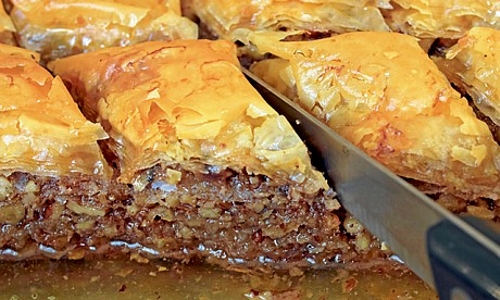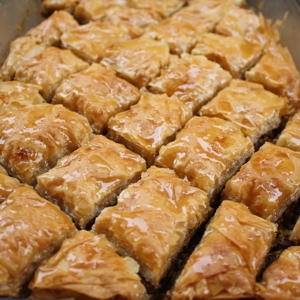Unless you are one of those very, very unfortunate people who has an allergy to Nuts or Honey, you’ll probably already know about the classic Middle Eastern candy/pastry treat called Baklava. Some folks think it’s hard to make – a true Mediterranean Mystery – but they’re wrong!
 Beautiful Baklava! Lebanese style:Swimming in aromatic Syrup
Beautiful Baklava! Lebanese style:Swimming in aromatic Syrup
and baked to a perfect golden brown…
Okay… Time to back-track a little…
Remember recently when we looked at another Mediterranean Mystery? Spanakopita? That’s the Greek classic featuring a Spinach and Feta Cheese filling between layers of crispy, Buttery Phyllo Pastry.
Baklava is really just a dessert version of that dish that’s popular from Greece right through Turkey, Lebannon and Syria and even as far afield as Tunisia, Libya, Algeria and Morocco – anywhere the Ottoman Empire had an outpost! Every region has it’s own special touches and ingredient variations…
Prepare the baking dish…
The technique of layering Phyllo Pastry with melted butter is common to a number of recipes from this part of the world. Lots of delectable pastries, in particular. But the one that started it all – arguably – is Baklava.
Melt a cup of butter in a saucepan over low heat ot in the microwave. buzzing for about 30 second, or until it’s all melted.
Start by buttering a casserole or baking dish liberally and laying in a sheet of Phyllo. Overlap sheets or cut them to ensure that the entire bottom of the dish is covered and that the pastry also runs up the sides of the dish over the top lip. We’ll be tucking these ends in later. Laminate three layers brushing with butter between each. Set the rest of your Phyllo aside under a damp tea towel to ensure that it doesn’t dry out. This is very important!
For the filing…
Start with two cups of shelled Pistachio nuts. You can use Walnuts or Hazelnuts or Almonds, or a blend of nuts if you wish. pistachios are traditional and have a flavour all their own. But they are also expensive! Chop the nuts by hand or use a food processor. You want them medium-chopped; not too fine!
In a big bowl, add the nuts first, then stir in 1 tsp. of ground Cinnamon, a couple of good pinches of ground Cloves, and 1/4 cup liquid Honey. Mix well, so that all the nut pieces are coated.
Pour the filling gently over the bottom layer of Phyllo and spread into a uniform layer, taking care not to tear the Phylo. Use your hands for this!
Then layer ten or so more layers of Phyllo over the filling, buttering between each, as before. Fold the protruding edges of the bottom layers of pastry over, onto the fist or second top layer above the filling. Then continue to add more pastry layers…
Finally, the syrup…
In a sauce pan on medium-low heat, combine 3 cups sugar with 1.5 cups water and stir until the sugar is completely dissolved. Add two tsp. of Rose Water, if you can get it. Check the baking specialty shops and Middle eastern supermarkets! Otherwise, use the juice of one Lemon or two tsp. of bottled juice. You may also want to throw in a few whole Cloves and a Cinnamon stick. Let the Syrup reduce and thicken until it is sticky but still pours easily.
Pre-cut the Baklava into portions as desired using a warm, sharp knife. Then pour the Syrup evenly ll over the top and let it run down the cracks betwen the portions.
Bake at 320 F for the first 15-20 minutes to set the bottom ‘crust’, then reduce oven to 300 F for another 15-20 minutes, until the top pastry payers are crispy and golden brown.
Let cool completely before serving, or the whole thing will fall apart and run all over the plate!
There you have it! Another famous Mediterranean Mystery solved!
~ Maggie J.

